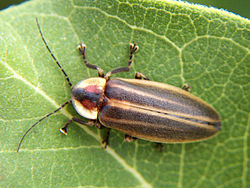| Photuris | |
|---|---|
 | |
| P. lucicrescens | |
| Scientific classification | |
| Domain: | Eukaryota |
| Kingdom: | Animalia |
| Phylum: | Arthropoda |
| Class: | Insecta |
| Order: | Coleoptera |
| Suborder: | Polyphaga |
| Infraorder: | Elateriformia |
| Family: | Lampyridae |
| Subfamily: | Photurinae |
| Genus: | Photuris Dejean, 1833 |
| Species | |
See text | |
Photuris is a genus of fireflies (beetles of the family Lampyridae). These are the lightning bugs of North America. This common name refers to a behavior of the adult females of these predatory beetles; they engage in aggressive mimicry, imitating the light signals of other firefly species' females to attract mates –but Photuris use it to attract, kill and eat the unsuspecting males of those other species. Their flashing bioluminescent signals seem to have evolved independently and eventually adapted to those of their prey, mainly unrelated Lampyrinae, such as Photinus (rover fireflies) or Pyractomena . [1]